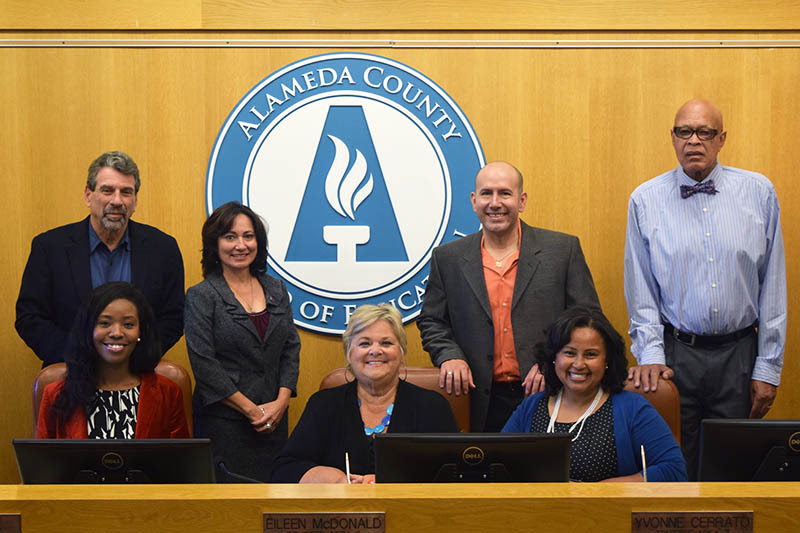| ACOE press release FOR IMMEDIATE RELEASE October 9, 2019 Press ReleasePublic Information Officer Laura Forrest, (510) 670-7754, [email protected] |
| Hayward, CA – Today the California Department of Education released the results of the California Assessment of Student Performance and Progress (CAASPP) tests administered during the 2018-19 school year. Smarter Balanced assessments are administered in third through eighth and 11th grades, with tests for English language arts/literacy (ELA) and mathematics. The assessments are rooted in California’s academic standards, which are more rigorous than previous standards. This is the fifth year of CAASPP testing results, which are reported in four tiers related to standards: not met, nearly met, met, or exceeded.The results show that with approximately 116,000 students tested across 18 school districts, Alameda County made modest gains in 2018-19 in both ELA and mathematics assessments over 2017-18 results, and continue to outperform state averages. While most student groups improved, Alameda County districts still have significant room for growth among African American students, Hispanic/Latino students, students with disabilities, and English learners.Across all of Alameda County’s schools, there was an increase in met or exceeded standard levels of 0.6 percent in ELA and 0.4 percent in mathematics from the 2017-18 results. “The students in our county continue to show positive growth in state assessments, and we are heartened by the hard work that is happening in our districts,” said Alameda County Superintendent of Schools L. Karen Monroe. “That being said, we want even more for our students. Significant gaps still persist for the county’s highest need students. The Alameda County Office of Education is fully committed to the work of Differentiated Assistance, where we have the opportunity to assist districts in achieving improved student outcomes for all.” Differentiated Assistance is a four-month process in which a district works in partnership with its county office of education to identify and resolve key challenges to better serve students most in need. In light of ACOE’s academic oversight role in relation to districts of Alameda County, Superintendent Monroe voiced continued concern about the county’s more vulnerable students, stating, “Critical work still needs to be done to ensure improved outcomes among students of color, students with disabilities, those who live in poverty, and particularly English learners. We need to see more accelerated growth for these students especially. “We continue to look at all subjects with an equity lens. Understanding the root of these student performance gaps is key to addressing them. Our targeted work with Differentiated Assistance has proven effective in helping districts shine a light on this real and urgent issue.” With only 35 percent of low-income students in Alameda County meeting or exceeding standards in ELA, the county-wide gap between low-income and non-low-income students remains nearly 40 percentage points. In mathematics, the county-wide gap between low-income and non-low-income students is greater than 40 percentage points, with only 26 percent of low-income students meeting or exceeding standards.There are two student assessment milestones that are widely viewed as critical benchmarks for measuring college and career readiness for students: third-grade literacy and eighth-grade mathematics. In Alameda County, 55.0 percent of third graders met or exceeded standards in ELA (an increase of 0.9 percent from 2017-18) and 47.2 percent of eighth graders met or exceeded standards in mathematics (a decrease of 1.2 percent). Results of the second year of English Language Proficiency Assessments for California (ELPAC) testing were released with the CAASPP results. The assessment, which is designed to measure the English proficiency of students designated as English learners, replaced the California English Language Development Test (CELDT) in 2018. ELPAC tests are administered when an English learner initially enrolls in a California school and annually until the student is reclassified as proficient in English. ELPAC results are not a reliable measure of year-to-year progress for districts, as students are no longer assessed after being reclassified as proficient in English. A more accurate measure of growth for this student group was built into the California School Dashboard with the English Learner Progress Indicator, which tracks growth for cohorts of English learners from year to year. The updated Dashboard data is set to be released in December. “We look forward to the release of the California School Dashboard later this year to provide us with more information that will better help us understand the performance of students and school districts,” said Superintendent Monroe. “Our schools and districts must continue to engage students and families, classroom content must continue to increase in rigor and relevance with equitable opportunities for students to succeed, and teachers need to be exposed to professional training that strengthens their ability to serve the needs of all students.” Assessments results are available to the public at the California Department of Education CAASPP webpage. For additional information, contact Laura Forrest at (510) 670-7754 or [email protected]. ###About ACOE The Alameda County Office of Education (ACOE), under the leadership of County Superintendent of Schools L. Karen Monroe, serves as liaison between the California Department of Education and the 18 Alameda County public school districts that serve more than 200,000 students and 10,000 teachers. ACOE provides oversight of district budgets and Local Control and Accountability Plans (LCAPs). ACOE directly operates two types of schools that serve Alameda County’s most vulnerable youth: Court Schools at the Juvenile Justice Center and Community Schools that serve foster youth, students in substance abuse treatment, pregnant and parenting teens, Probation-referred youth, and students expelled from their resident school districts. ACOE also runs the Infant & Family Support Program, which provides individualized service for children from birth to three years and their families. For more information, visit www.acoe.org. |
What do you think?

